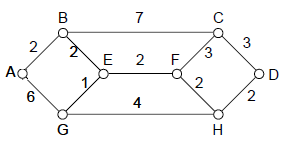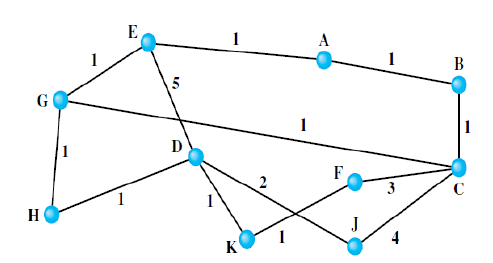This set of tricky Network Security questions and answers focuses on “Layers – III”.
1. A pure ALOHA network transmits 200-bit frames on a shared channel of 200 kbps. What is the requirement to make this frame collision-free?
a) 2msec
b) 4msec
c) 2sec
d) 4sec
View Answer
Explanation: Average frame transmission time
Tfr = 200 bits/200 kbps or 1 ms
Vulnerable time = 2x Tfr = 2 × 1 ms = 2 ms.
2. A pure ALOHA network transmits 200-bit frames on a shared channel of 200 kbps. What is the throughput if the system (all stations together) produces 1000 frames per second?
a) 150 frames
b) 80 frames
c) 135 frames
d) 96 frames
View Answer
Explanation: Frame transmission time
Tfr= 200/200 kbps or 1 ms.
If the system creates 1000 frames per second, or 1 frame
per millisecond, then G = 1
S = G × e−2G = 0.135 (13.5 percent)
This means that,
Throughput =1000 × 0.135 = 135 frames.
3. A pure ALOHA network transmits 200-bit frames on a shared channel of 200 kbps. What is the throughput if the system (all stations together) produces 500 frames per second?
a) 146 frames
b) 92 frames
c) 38 frames
d) 156 frames
View Answer
Explanation: If the system creates 500 frames per second, or 1/2 frames per millisecond.
Then G = 1/2.
S = G × e−2G = 0.184 (18.4 percent)
This means that
Throughput = 500 × 0.184 = 92
Only 92 frames out of 500 will probably survive
This is the maximum throughput case, percentage-wise.
4. A pure ALOHA network transmits 200-bit frames on a shared channel of 200 kbps. What is the throughput if the system (all stations together) produces 250 frames per second?
a) 38 frames
b) 48 frames
c) 96 frames
d) 126 frames
View Answer
Explanation: If the system creates 250 frames per second, or 1/4 frames per millisecond, then G = ¼.
S = G × e−2G = 0.152 (15.2 percent).
This means that
Throughput = 250 × 0.152 = 38.
Only 38 frames out of 250 will probably survive.
5. A slotted ALOHA network transmits 200-bit frames using a shared channel with a 200-kbps bandwidth. Find the throughput if the system (all stations together) produces 1000 frames per second.
a) 92 frames
b) 368 frames
c) 276 frames
d) 151 frames
View Answer
Explanation: G =1 S=G×e−G=0.368 (36.8%)
Throughput = 1000 × 0.0368 = 368 frames.
6. A slotted ALOHA network transmits 200-bit frames using a shared channel with a 200-kbps bandwidth. Find the throughput if the system (all stations together) produces 500 frames per second.
a) 92 frames
b) 368 frames
c) 276 frames
d) 151 frames
View Answer
Explanation: G=1/2 S = G × e−G = 0.303 (30.3 percent)
Throughput is 500 × 0.0303 = 151.
7. A network using CSMA/CD has a bandwidth of 10 Mbps. If the maximum propagation time (including the delays in the devices and ignoring the time needed to send a jamming signal, as we see later) is 25.6 μs, what is the minimum size of the frame?
a) 128 bytes
b) 32 bytes
c) 16 bytes
d) 64 bytes
View Answer
Explanation: The minimum frame transmission time is Tfr = 2 × Tp = 51.2 μs. This means, in the worst case, a station needs to transmit for a period of 51.2 μs to detect the collision.
The minimum size of the frame is 10 Mbps × 51.2 μs = 512 bits or 64 bytes. This is actually the minimum size of the frame for Standard Ethernet.
8. In collision free protocol channel efficiency is given by-
a) d/(d + log2(N))
b) d*(d + log2(N))
c) log2(N)
d) (d + log2(N))
View Answer
Explanation: In collision free protocol channel efficiency is given by d/(d + log2(N)).
9. 
Find the distance from source A to destination D using Dijkstra algorithm.
a) 10
b) 11
c) 12
d) 14
View Answer
Explanation:
The shortest path form A to D is ABEFHD and distance is 10.
10. 
Find the distance from source A to destination D using Dijkstra algorithm.
a) A-B-C-J-D-K
b) A-B-C-G-H-D-K
c) A-E-D-K
d) A-E-G-H-D-K
View Answer
Explanation:
Shortest path is: A-E-G-H-D-K and the distance is 5 units.
11. After performing bit stuffing on the following stream : 01101111111111111110010, the output is-
a) 01101111101111101111100010
b) 01101111111111111110010111
c) 10010000000000000000001101
d) 01101111111111111111110010
View Answer
Explanation: Bit stuffing involves adding a 0 after every five 1s during transmission.
Sanfoundry Global Education & Learning Series – Cryptography and Network Security.
To practice tricky questions on all areas of Network Security, here is complete set of 1000+ Multiple Choice Questions and Answers.
If you find a mistake in question / option / answer, kindly take a screenshot and email to [email protected]
- Practice Computer Science MCQs
- Check Cryptography and Network Security Books
- Apply for Computer Science Internship
- Check Computer Science Books
- Practice Cyber Security MCQ
